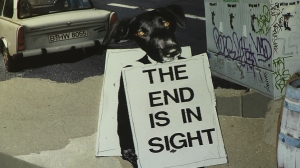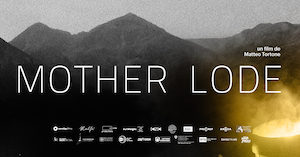Un film d’Andrew Cohen, being edited / A-C Films
Switzerland, Germany, in post-production with C-Side Productions
SYNOPSIS:
The Berlin Wall fell in 1989. Later that year, a group of activists and artists streamed into East Berlin and squatted a derelict ruin. The art house Tacheles —a Hebrew word meaning “straight talk”— was born from the ashes of this bombed-out building. The biography of this building, starting with its construction in 1907, in many ways encapsulates a century of German history –from the pre-World War I prosperity and subsequent depression, to World War II and the Soviet occupation, and the birth and death of the DDR.
Jochen Sandig, one of the original squatters of the house, recounts his dream of a better society and of an art house that could support it’s own existence. Through their art, the artists in the squat try to preserve old Berlin. One protagonist, Tim Roeloffs (a former homeless tennis pro) found shelter in the squat and reinvented himself as a photomontagist, creating works about the fast dis! appearing culture of the former East Berlin, and the white-washing of the bullet-ridden buildings. Another artist, Martin Reiter, created installations that comment on the Berlin’s Nazi past and the warring nature of society.
Tacheles still stands, in Mitte, the gentrified center of the now united Berlin. Real estate developers continue trying to evict the artists in order to turn the property into a shopping mall, with swank hotels, restaurants and apartments. Karl Maschmeir, of the investment firm Fundus company, has his own vision: to turn the neighborhood into a Berlin version of Soho, New York, his office filled with models of the new gleaming and white-washed neighborhood he wishes to create. The battle lines were drawn, one that takes its toll on both the artists and investors.
The artists’ work focuses on the battle against corporate occupation, while the investment company fights to stave off looming bankruptcy.
Money has changed the art of all the artists. Martin Reiter no longer creates installation art but leads the fight now against gentrification and eviction. His art is a politically based performance fight against the money of the investors.
Meanwhile, Donatella Versace discovers Tim Roeloffs, and a rags to riches story unfolds, as Roeloff’s’ work is used on the dresses and accessories of Versace. His art loses its edge, but not its humor. No longer free with his work, he wants/needs to support his growing family and sells out to the masses who want him to! make postcard and poster art. Tacheles becomes a shop to sell his new “art product,” and he buys his own printing factory to mass produce his work.
Sandig said goodbye to his dream years ago to pursue a career as director of an establishment cultural house. But, for the rest of the artists in the house, luck was not on their side. They face eviction and the loss of their free studios –and alternative art culture that exists outside the gallery system. The drive to create art is once again replaced by the fight for survival. Each protagonist had dreams that were realized, broken, and changed –and their art reflects all this. The Fundus company went bankrupt and now another investment firm has taken on the fight to evict the artists. The battle for free art continues…
OTHER FILMS (A-C Films) IN POST-PRODUCTION:











